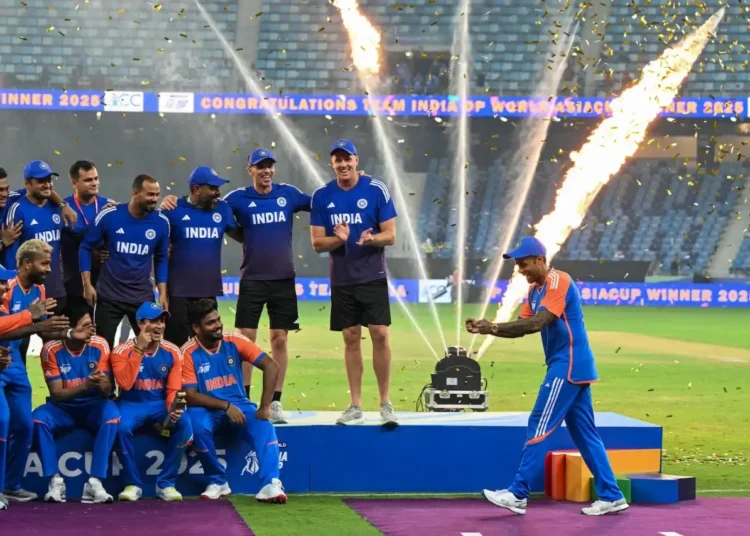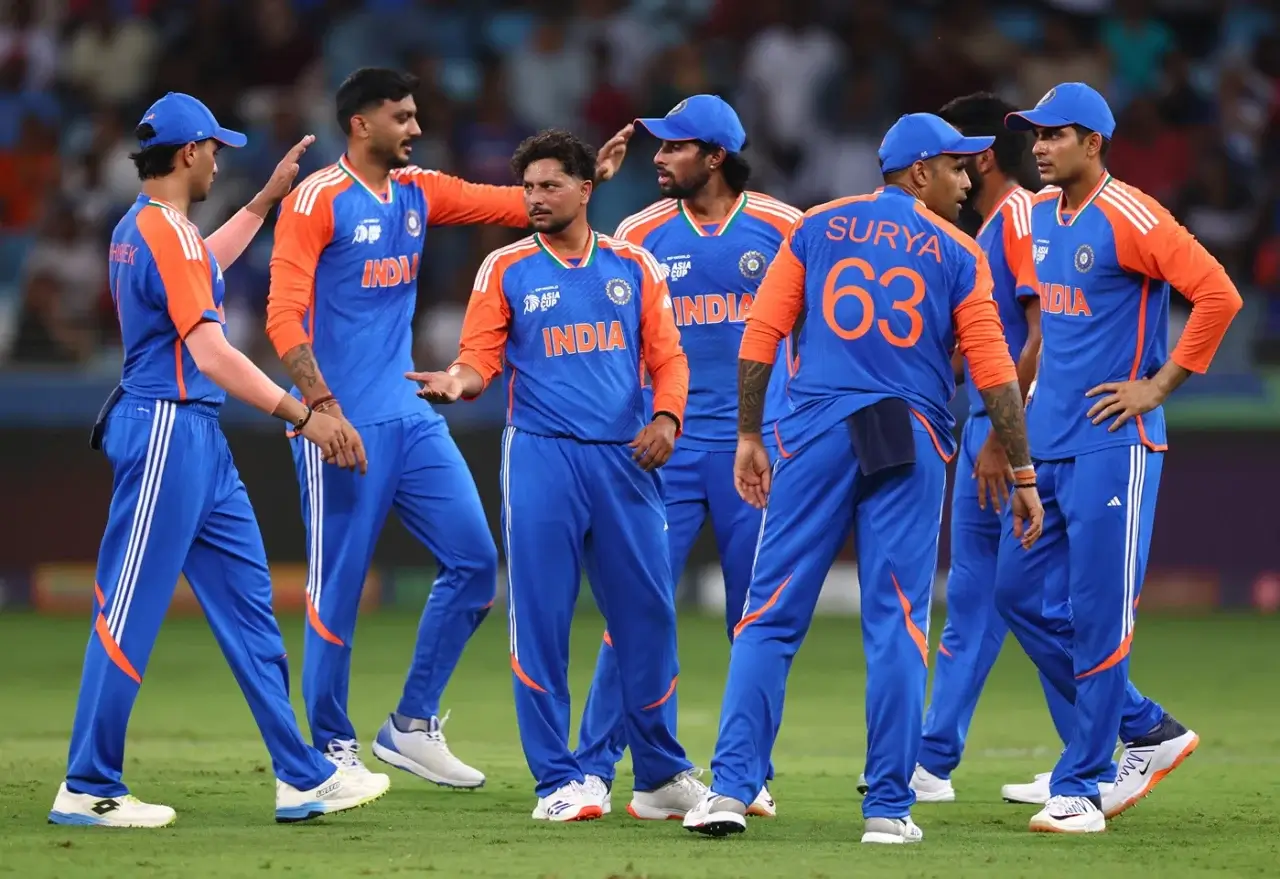India lifted their ninth Asia Cup title with a mix of calm and chaos under the Dubai lights. Chasing one hundred forty seven, they stumbled to twenty for three and panic spread quickly. The pressure of a packed stadium and a billion expectations loomed large. Yet what unfolded was a final that combined spin brilliance with batting composure.
Kuldeep Yadav sparked a Pakistan collapse that turned the match on its head. His four for thirty included a triple strike in one over that broke their backbone. Varun Chakravarthy’s mystery also haunted Pakistan, dismissing the only two set batters. That collapse flipped the contest from a strong position at 107 for 1 into 146 all out.
On the other side Tilak Varma scripted a chase built on timing, patience, and problem-solving. He soaked up early pressure, played risk-free cricket, and finished unbeaten on sixty nine. His partnership with Shivam Dube was the game’s turning point as both showed clarity in roles. With Rinku Singh finishing it off, India sealed victory with five wickets and composure intact.
This wasn’t just about runs and wickets. It was about temperament, strategy, and absorbing the chaos of a high-voltage final. From Kuldeep’s ripping spin to Tilak’s cool head, India combined skill with mental steel to reclaim their dominance over their fiercest rivals.
Kuldeep and Varun trigger Pakistan’s collapse
Pakistan’s innings told a story of bold starts and reckless endings. Sahibzada Farhan swung hard, connecting just enough to raise hopes with a rapid half-century. Fakhar Zaman added forty six and both combined to put pressure on Kuldeep early. At 107 for 1 with more than seven overs left, Pakistan looked set for a big finish.
Then the spin duo tore through. Chakravarthy outfoxed both openers with turn and deception, breaking the momentum instantly. Kuldeep, after conceding in his first spell, returned with fire and grabbed three wickets in a single over. The collapse unfolded brutally, with nine wickets tumbling for thirty nine runs.
Axar Patel chipped in too, using accuracy and subtle changes of pace to strangle scoring. Pakistan’s lower order resorted to slogging but only found mistimed hits and fielders waiting. The scoreboard, once promising, turned disastrous as they folded inside twenty overs. The entire batting order outside Farhan and Fakhar failed to cross fifteen.
What defined this collapse was India’s tactical discipline and refusal to panic after the early assault. By trusting spin in the middle overs, Suryakumar Yadav’s captaincy forced Pakistan into rash strokes. This shift left India chasing a par score instead of a daunting target, laying the foundation for what came next.
Why India’s spinners were decisive?
Kuldeep and Varun’s success was no accident, it was strategy at work. Pakistan had struggled against mystery and wrist spin throughout the tournament, and India exploited it fully. By holding back Varun until the openers were settled, they forced risk-taking into his hands. Kuldeep, trusted despite early punishment, responded with confidence and control.
These choices reflected trust in process and clarity in roles, not reactive thinking. Captains and selectors will note how this spin blueprint suffocated Pakistan’s hitters into mistakes. With wrist spin and mystery combined, India created pressure through variety and constant questions. This duo may now become the spine of India’s white-ball middle-overs strategy heading into future tournaments.
Tilak’s composure and Dube’s cameo define the chase
India’s chase began in chaos, losing Abhishek Sharma early and wobbling to twenty for three. Shubman Gill failed, and even Suryakumar couldn’t settle as Pakistan’s pacers roared. The crowd turned louder, the tension crackled, and belief briefly shifted away from India. That’s when Tilak Varma decided the match needed calm, not counterattack.
He began watchfully, defending with soft hands and picking singles with precision. A back-foot punch through cover showed his timing was locked in, even on a slow pitch. By choosing the right balls to attack, Tilak ensured the chase never spiraled into desperation. When Haris Rauf returned with pace, Tilak cashed in with a seventeen-run over that flipped momentum again.
Shivam Dube entered at the other end with his own script. Two sixes — one off spin down the ground and another off Ashraf over long-on — changed the tempo. His thirty three off twenty two provided the acceleration Tilak needed as an anchor. Their partnership of sixty off forty balls was the bridge that carried India out of danger.
When Dube fell near the end, Tilak carried the load with serenity. A six off Rauf in the 19th over showcased his reading of conditions and composure. With Rinku Singh adding the final touch, the chase was complete with five balls left. Tilak’s celebration, with heart signs and roars, summed up a journey from pressure to glory.
What Tilak’s innings means for India?
Tilak’s knock was more than numbers, it was proof of maturity. He showed that a young batter can anchor a chase without panicking or slogging. His strike rotation, patience, and timely bursts reflect qualities usually seen in seasoned players. The unbeaten sixty nine became not just a match-winning effort but a statement innings.
For selectors, this chase offers clarity on his role in future white-ball matches. He can now be trusted to stabilize shaky starts and build through middle overs. For teammates, his calmness under pressure inspires belief in high-stakes moments. For fans, his celebration showed both relief and confidence, signaling that India has found another dependable finisher.
How earlier wins built momentum?
India’s campaign was not defined by just this final, but by steady growth. Dominant wins against Bangladesh and Hong Kong built rhythm, sharpened roles, and lifted belief. Against Bangladesh, the team handled spin with patience and middle-order strength. Against Hong Kong, seamers delivered early breakthroughs that freed batters to attack confidently.
These matches allowed experimentation and role testing across batting and bowling units. Bench players gained meaningful minutes, turning practice into trust and selection flexibility. Coaches used these fixtures to simulate pressure chases and finishing drills under match conditions. The preparation translated directly into confident choices and calm executions under Dubai’s bright lights.
The India vs Bangladesh timeline shows how tactical adjustments and player roles evolved across games. (See: https://cricketstadium.com.in/india-national-cricket-team-vs-bangladesh-national-cricket-team-timeline/.) Adding that context connects this win to the larger journey of the campaign. It also reinforces how momentum from earlier matches shaped India’s composure on the big night.
Lessons India carries forward
The Asia Cup taught India the importance of rehearsed scenarios and role clarity. Bench minutes ensured that replacements like Dube and Rinku could deliver when needed. Spin dominance showed how flexible bowling combinations can transform matches under pressure. Batting stability through Tilak displayed that calm process wins over reckless counterattacks in finals.
Going forward, India now has a clearer blueprint for high-pressure chases. Anchors like Tilak can blend with finishers like Dube and Rinku to balance innings. Wrist spin and mystery bowling can dominate middle overs and create collapses when needed. These lessons extend beyond the Asia Cup and into bigger tournaments ahead.
Conclusion
India’s ninth Asia Cup title will be remembered for spin fire and batting calm. Kuldeep and Varun turned Pakistan’s dominance into collapse, showing spin’s power in modern white-ball cricket. Tilak and Dube then stitched together a partnership that reflected clarity, patience, and aggression. Rinku’s finishing touch wrapped up a final that combined chaos with composure.
For selectors, this victory provides proof of role clarity and bench depth. For coaches, it validates preparation methods and scenario rehearsals across earlier matches. For fans, it delivered a classic India-Pakistan finale filled with skill, drama, and raw emotion. From start to finish, the match showcased why cricket is as much mental as technical.
India’s campaign built from steady wins to a charged finale under Dubai’s lights. Tilak’s calm and Kuldeep’s spin will headline, but every role mattered across the campaign. This was not just a win but a roadmap for future success under pressure. And above all, it reminded the world that India remain masters of adapting, planning, and finishing.
















